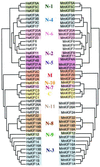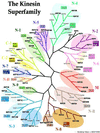All kinesin superfamily protein, KIF, genes in mouse and human
- PMID: 11416179
- PMCID: PMC34614
- DOI: 10.1073/pnas.111145398
All kinesin superfamily protein, KIF, genes in mouse and human
Abstract
Intracellular transport is essential for morphogenesis and functioning of the cell. The kinesin superfamily proteins (KIFs) have been shown to transport membranous organelles and protein complexes in a microtubule- and ATP-dependent manner. More than 30 KIFs have been reported in mice. However, the nomenclature of KIFs has not been clearly established, resulting in various designations and redundant names for a single KIF. Here, we report the identification and classification of all KIFs in mouse and human genome transcripts. Previously unidentified murine KIFs were found by a PCR-based search. The identification of all KIFs was confirmed by a database search of the total human genome. As a result, there are a total of 45 KIFs. The nomenclature of all KIFs is presented. To understand the function of KIFs in intracellular transport in a single tissue, we focused on the brain. The expression of 38 KIFs was detected in brain tissue by Northern blotting or PCR using cDNA. The brain, mainly composed of highly differentiated and polarized cells such as neurons and glia, requires a highly complex intracellular transport system as indicated by the increased number of KIFs for their sophisticated functions. It is becoming increasingly clear that the cell uses a number of KIFs and tightly controls the direction, destination, and velocity of transportation of various important functional molecules, including mRNA. This report will set the foundation of KIF and intracellular transport research.
Figures



Similar articles
-
Kinesin superfamily proteins (KIFs) in the mouse transcriptome.Genome Res. 2003 Jun;13(6B):1455-65. doi: 10.1101/gr.984503. Genome Res. 2003. PMID: 12819144 Free PMC article.
-
Identification and classification of 16 new kinesin superfamily (KIF) proteins in mouse genome.Proc Natl Acad Sci U S A. 1997 Sep 2;94(18):9654-9. doi: 10.1073/pnas.94.18.9654. Proc Natl Acad Sci U S A. 1997. PMID: 9275178 Free PMC article.
-
Kinesin superfamily proteins and the regulation of microtubule dynamics in morphogenesis.Anat Sci Int. 2015 Jan;90(1):1-6. doi: 10.1007/s12565-014-0259-5. Epub 2014 Oct 28. Anat Sci Int. 2015. PMID: 25347970 Review.
-
The molecular mechanism of organelle transport along microtubules: the identification and characterization of KIFs (kinesin superfamily proteins).Cell Struct Funct. 1996 Oct;21(5):357-67. doi: 10.1247/csf.21.357. Cell Struct Funct. 1996. PMID: 9118241 Review.
-
Intracellular transport and kinesin superfamily proteins, KIFs: structure, function, and dynamics.Physiol Rev. 2008 Jul;88(3):1089-118. doi: 10.1152/physrev.00023.2007. Physiol Rev. 2008. PMID: 18626067 Review.
Cited by
-
Impact of KIF4A on Cancer Stem Cells and EMT in Lung Cancer and Glioma.Cancers (Basel). 2023 Nov 22;15(23):5523. doi: 10.3390/cancers15235523. Cancers (Basel). 2023. PMID: 38067227 Free PMC article.
-
A kinetic dissection of the fast and superprocessive kinesin-3 KIF1A reveals a predominant one-head-bound state during its chemomechanical cycle.J Biol Chem. 2020 Dec 25;295(52):17889-17903. doi: 10.1074/jbc.RA120.014961. Epub 2020 Oct 20. J Biol Chem. 2020. PMID: 33082143 Free PMC article.
-
Molecular characterization of a KIF3B-like kinesin gene in the testis of Octopus tankahkeei (Cephalopoda, Octopus).Mol Biol Rep. 2012 May;39(5):5589-98. doi: 10.1007/s11033-011-1363-4. Epub 2011 Dec 20. Mol Biol Rep. 2012. PMID: 22183304
-
Expression of kinesin superfamily genes in cultured hippocampal neurons.Cytoskeleton (Hoboken). 2010 Dec;67(12):784-95. doi: 10.1002/cm.20487. Epub 2010 Nov 2. Cytoskeleton (Hoboken). 2010. PMID: 20862690 Free PMC article.
-
The kinesin KIF1C and microtubule plus ends regulate podosome dynamics in macrophages.Mol Biol Cell. 2006 Jun;17(6):2811-23. doi: 10.1091/mbc.e05-11-1010. Epub 2006 Mar 22. Mol Biol Cell. 2006. PMID: 16554367 Free PMC article.
References
Publication types
MeSH terms
Substances
Associated data
- Actions
- Actions
- Actions
- Actions
- Actions
- Actions
- Actions
- Actions
- Actions
LinkOut - more resources
Full Text Sources
Other Literature Sources
Molecular Biology Databases
Research Materials

